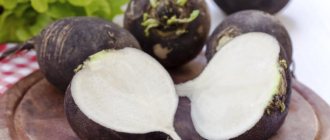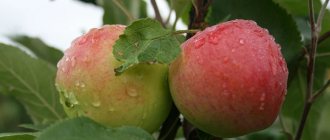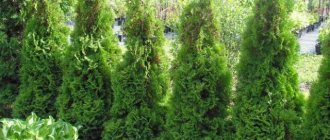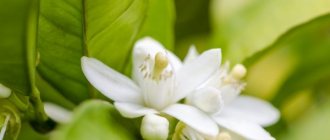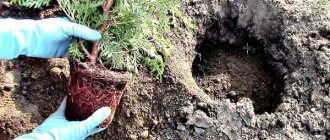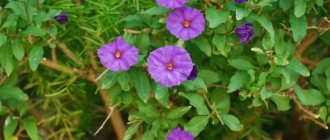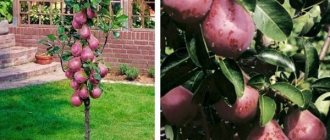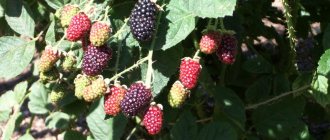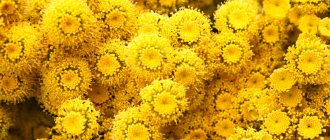In park landscaping, coniferous plants are very popular because, among other advantages, they have the ability to remain green all year round. Thuja Smaragd is well known to landscape designers and is loved for its unpretentiousness to lighting and soil composition. Its compact, neat crown goes well with flower arrangements and does not lose its attractiveness in winter.
Botanical description
Western thuja Smaragd (lat. Thuja occidentalis Smaragd) is a variety that is part of the western thuja species (lat. Thuja occidentalis). On its basis, many hybrids with different habit and color of needles have been bred. The standard is distinguished by a conical crown shape and moderate annual growth. A monoecious plant lives up to 100-130 years or more.
A tree aged 10 years reaches a height of about 2.5 m. Usually the size of adult specimens does not exceed 4-6 m. The crown diameter ranges from 1-1.8 m. The growth rate of thuja Smaragd in height is on average up to 10 cm per year , and in width - no more than 4-6 cm.
The narrow-conical crown has medium density. The branches of the plant for the most part tend to have weak branching. The shoots grow at an acute angle to the trunk and are directed upward. Young branches have glossy bark and remain light green all year round. Some varieties have the ability to change the shade of the crown with the changing seasons. Western thuja perfectly accepts formative pruning, so if desired, you can abandon the classic conical shape and give the plant the appearance of a cylinder, ball, spiral, etc.
The needles are scaly, light green, shiny leaves that usually do not change color with the changing seasons. Winter hardiness is down to -36 °C, which makes it possible to grow Smaragd thuja in open ground almost everywhere, including in the Moscow and Leningrad regions. The seeds ripen closer to autumn in small brown oblong-ovoid cones (up to 1 cm in length).
What types of thujas are there?
Now there are a huge number of varieties with different characteristics and appearance. You can buy a thuja mix, which will contain several different varieties at once.
Important! Before purchasing one or another plant variety, you need to study all existing varieties.
Western
Western thuja (in Latin Thuja occidentalis) is an evergreen coniferous tree. Young specimens are distinguished by a pyramidal crown. As it grows, it becomes cone-shaped.
Eastern
This variety grows in temperate climates with warm winters. In its natural environment it grows on rocks. Reaches up to 10 m in height.
Gigantic
Thuja giant, or folded, grows up to 70 m in height. Decorative varieties of this variety grow more miniature.
Japanese
This variety is distinguished by its demands on air purity, so it does not take root in urban environments. In its natural environment it grows in high mountain areas.
Japanese variety
Korean
This variety belongs to the shrubs. The plant looks like a creeping crop, the lower branches lie almost on the ground. The underside of the crown is silvery, the upper side is green.
Variety varieties
In landscape design, all kinds of varieties and hybrids are used, obtained from the thuja occidentalis Smaragd. You can choose a compact, low-growing seedling with unusually colored needles, or give preference to a tall tapeworm.
Thuja White Smaragd (Vitbont)
The variety is distinguished by increased crown density and a clearly defined sharp crown. Adult specimens reach 3 m in height and up to 1 m in width. The growth rate depends on the region - it is minimal in the Moscow region and to the north; in the south, seedlings grow faster. The young bark is reddish-brown in color and becomes gray-brown as it ages. In summer, young shoots of thuja are very light, almost yellow, with white or creamy-variegated ends, and in winter they are light green. Small shoots live for 2-3 years and then fall off. Flowers form in autumn and bloom in April-May. A ripe cone is brown, up to 7 mm long, with only 2 seeds inside.
Thuja Smaragd Variegata
An adult specimen reaches a height of 5 m and a width of up to 180 cm. The annual growth in height is up to 10 cm and in width up to 4 cm. A tree at 10 years old has a height of about 2.5 m. The peculiarity of the variety is its needles. All branches are covered with bright green shiny soft scales, but at the ends they are colored almost white. It accepts formative pruning well when no more than a third of the shoot length is removed at a time.
Thuja Smaragd Spotti
The crown of this variety looks very decorative. On the main light green background of pine needles, milky inclusions are randomly scattered. This gives the thuja additional visual volume. This thuja looks especially impressive next to dark green conifers. The height of the conical tree is about 3 m, and the width does not exceed 1 m. The annual growth in height is about 10 cm, in width - up to 4 cm. It is distinguished by its high shade tolerance, as well as its demands on soil fertility.
Thuja Smaragd Yellow Ribbon
Young needles are orange in early spring, turn golden-green in summer, and darken to bronze closer to winter. At 15 years old, this thuja reaches a height of about 2-2.5 m with a width of about 80 cm. The annual growth in height is up to 12 cm, and in width - up to 8 cm. The crown is conical, closer to teardrop-shaped. The crown of this variety stands out for its density due to increased branching.
The best varieties and types of thuja for growing
Planting thuja on the site will become a wonderful resting place, where you can stock up on vital energy and inhale the aroma of a coniferous plant.
Depending on the shape of the crown, the types of plants are determined:
The Chinese type of tree is lower, but has a dense pyramid-shaped crown.
The perennial tree is distinguished by its small, scaly needles, which are pressed tightly against the shoots. The bark of many types of thuja is smooth, reddish or gray-brown in tone, depending on the variety. To successfully grow thuja, you need to know what the structure of the root system is and how to care for it.
Spreading
The western thuja is native to North America, where it is found in southeastern Canada and the northern United States. The crop was brought to Europe in the 16th century and has since been cultivated everywhere in gardens and parks. In Russia, varieties of the Smaragd group are very popular and are cultivated in almost all regions, with the exception of the very dry southern ones (the plant needs a lot of moisture, especially in summer).
Wild-growing forms are easy to distinguish from garden ones - they are taller and do not have such a clear configuration. The crop tolerates fairly strong shading, which allows it to survive in dense forest conditions. Seeds readily germinate in fertile, well-moistened soil with a low level of groundwater.
The structure of the root system of a coniferous plant
In order for a coniferous tree to develop and produce annual growth, it is necessary to provide favorable conditions for the root system of the plant. In all types of thuja, the roots are branched and located horizontally to the surface of the earth, without lying deep.
To make the root system of the tree compact, first grow the shrub in containers.
Although it is difficult to separate the roots from one another when transplanting, a closed root system will not take up much space on the site. The plant prefers to be placed in fertile soil. Then there will be enough substances for the growth of the thuja, and the crown will become fluffy and bright in color.
The success of growing ephedra depends on the conditions in which its branched roots are located:
- A closed root system involves planting in April or October with thin roots placed in bags and containers. The roots are provided with drainage by pouring expanded clay, broken brick or pebbles onto the bottom of the planting hole. The soil contains peat and sand. When planting a bush, do not forget that the root collar should not be below the ground level. When the neck is buried, the thuja will die. When planting thuja for a hedge, they dig a trench, placing the roots of each plant compactly in it.
- With an open root system, the tree is located naturally in the ground. But then it is better to plant thuja in the spring, so that over the summer and autumn the perennial will become stronger and withstand the winter. Depending on the type of thuja, shrubs are planted at a distance of one to three meters from each other. This will allow the root system to grow freely.
Planting and care
Thuja Smaragd should be planted in open ground in the following order in early spring or autumn (September):
- Dig a hole up to 1 m wide and up to 80 cm deep at some distance from the walls of buildings, fences and large trees. Drafts are contraindicated, especially for young trees. The place is chosen so that at least part of the day it is in bright light.
- The bottom of the pit is lined with fine gravel, crushed stone, broken brick or expanded clay for drainage (layer up to 15 cm thick).
- 500-600 g of wood ash and 40 g of superphosphate are mixed into the excavated soil.
- The seedling is placed so that the root collar is slightly above ground level.
- Cover the roots with fertile soil.
- The trunk circle is mulched (needles, sawdust, chopped bark or grass, etc.).
- After some time, the ground will settle and you will need to add fertile soil.
If we are not talking about a single planting, but about growing a hedge, then a distance of 2-5 m (minimum 70 cm) is left between seedlings of thuja Smaragd, depending on the size of the variety. Over time, such a wall will become very dense. Caring for thuja Smaragd is not difficult, so it is often recommended for beginners.
Watering in the hot season is required only when there is no rain during the week. Consumption per tree is at least 10 liters of water. It is best to water in the morning or evening so that the needles do not dry out in bright sunlight. In cities, it is useful to sprinkle the crown to wash away dust and maintain humidity.
A year after planting, thuja Smaragd seedlings are not fertilized at all. This time is used for active growth of roots, which are threatened by high concentrations of fertilizers. From the 2nd year in the spring, a complex mineral fertilizer for conifers is applied, and at the end of summer the soil around the trunk is loosened, adding compost. It is very important to follow the following rules:
- Nitrogen fertilizers are applied only in the spring, since their task is to stimulate the active growth of young needles.
- The day before fertilizing, water the soil generously.
- In the fall, you cannot fertilize thuja Smaragd, so as not to provoke its growth instead of preparing for the dormant period.
Autumn time, after stable negative night temperatures have been established, is used to install shelters around seedlings for 1-2 years. “Huts” are made for them from slats and white non-woven material. Their task is to protect delicate branches from deformation and breakage from wind, icicles, frost, and heavy snow caps. In spring, the shelter is removed and sanitary pruning is carried out.
How to propagate thuja Smaragd
There are 3 traditional ways of propagating gymnosperms at home - seeds, cuttings and horizontal branches. The latter is quite rarely used for Smaragd, since it does not guarantee the preservation of the conical shape. It is much easier to buy seeds from a trusted manufacturer than to collect them yourself
Important! It has been proven that seed germination for many producers reaches almost 90%, in contrast to 50% at home.
The most popular method of propagating thuja Smaragd is cuttings
The most popular method of propagating thuja Smaragd is cuttings. In early spring, strong branches up to 15 cm long are cut off from it and lowered first into water to form primary roots, then into the soil mixture. Rooted shoots are transplanted after 1-2 years.
Reproduction
Thuja Smaragd seeds are propagated only in specialized nurseries. The reason is the very high labor intensity of the process. It takes 5 years from sowing to planting in open ground.
It is much easier to propagate thuja from cuttings. This is usually done in September. Select healthy and strong branches with non-lignified bark from the middle of the trunk. The branch is torn off with a piece of bark (with a “heel”). The optimal cutting length is 50 cm. Planting is carried out in a mixture of peat and soil (1:1), covering the top with a transparent cap to protect the needles from drying out.
The optimal temperature for keeping cuttings is +23 °C in bright, diffused lighting. The cap is removed daily to ventilate and spray the needles. Successfully rooted specimens are transplanted to a permanent place in open ground next spring (May).
What is the root system of thuja?
Thuja is an unpretentious shrub that can easily tolerate different soil compositions. But on fertile soil you can expect more fluffy needles from it. Thuja loves the sun, but not direct sunlight all day long. Therefore, it is worth considering tree planting not only from a design point of view, but also from a biological one.
The most optimal place for the tree will be partial shade, but the full shady side will not allow the crown to fluff up beautifully. The choice of planting site will not affect the quality or growth of the shrub in any way: dense, thin roots, intertwining with each other, form a compact single system.
Diseases and pests
For thuja Smaragd, the most dangerous are fungal diseases, as well as some pests:
- late blight - gives the needles a grayish tint, the trunk becomes soft from below. They fight the disease at the initial stage by watering with fungicides, and if there is no desired effect, the affected plant is destroyed;
- browning of shoots in early spring is of a fungal nature. It helps to reduce the acidity of the soil by diluting it with limestone, as well as spraying the crown with “Fundazol”; the affected branches are cut out and burned;
- thuja false scale - can destroy an adult tree. Appears as spots on branches and yellow sores on the bark. Spraying with an alcohol solution or specialized insecticides helps.
Why does thuja turn yellow?
Often, when growing thuja, you have to deal with such a problem as yellowed needles. There can be many reasons, but most often the problem lies in improper care.
Why does the thuja turn yellow:
- The thuja is affected by fungal diseases, due to which the needles turn yellow and the shoots acquire a brown tint. You can save the tree in the following way: cut off all damaged shoots and burn them. Spray the plant itself with fungicides;
- the tree may begin to dry out due to thuja aphids. If you do not start fighting insects in time, they can destroy the tree. Spraying with karbofos will help get rid of the pest;
- Thuja occidentalis often turns yellow due to false scale insects. The first sign is that reddish growths, similar to cones, begin to appear on the needles. The drugs karbofos and rogor are effective in controlling the pest.
Note! Irregular watering, lack of nutrients or drying out of the soil also contribute to yellowing of the needles.
If the needles of a thuja turn yellow, what to do:
- First of all, it is worth analyzing watering. Were there any disturbances in it, did the soil dry out?
- inspect the tree. The cause of yellowing may lie in insects;
- add mineral or organic fertilizers if they have never been added before or added, but rarely.
A quick response to this problem will allow you to deal with it immediately and not lead to the death of the tree.
The needles turn yellow
Use in landscape design
A beautiful tree, Thuja Smaragd, decorates any area, cleans the air of dust and harmful microflora, and enriches it with healthy phytoncides. Trees are planted in different ways, following the set goal:
- hedges in one or two rows for zoning space and delineating boundaries;
- single plantings with artistic crown trimming;
- simultaneous planting of several varieties in the form of a compact group to create a picturesque corner in the garden.
A wide variety of varieties and an affordable price for seedlings allows you to get the desired design with an almost 100% guarantee of success, since the plant is unpretentious.
Features of care in summer
Thuja Holmstrup - description and dimensions
On hot summer days, thuja should be protected from scorching rays. A small structure above the tree is suitable for this.
Periodically you need to remove weeds and eliminate insect nests. Regular loosening of the soil will ensure good air circulation to saturate the roots with oxygen.
It is useful to mulch the soil once a year. This will protect the area from the formation of weeds and retain moisture.
Mulching the soil
Possible growing problems and their solutions
Many types of thuja are frost-resistant, so if the needles turn brown in winter, then this is a natural process. In spring it will turn green. If this does not happen, then most likely the roots were exposed to low temperatures.
Lack of nutrition in the soil affects the condition of the tree. You cannot place tree roots in sandy soil, as moisture will go deeper, causing the roots to dry out. It is difficult to fully develop in clay soil due to lack of oxygen. Areas with stagnant water will lead to rotting of the root system. The ideal soil would be well-drained and slightly moist. This is a mixture of turf soil with the addition of sand and peat. The deepening of the root collar or its openness has a bad effect on the appearance of the thuja. In both cases, the plant will begin to wither.
In order for the root system to develop freely, the distance between tree plantings must be at least a meter.
Fertilizers for the plant are required in emergency cases. Excesses of them in the soil lead to drying of the tips of the shoots. But the lack of elements will also affect the condition of the thuja. If the needles have turned red-violet, you need to urgently add fertilizers with phosphorus to the soil. The crown will turn pale due to lack of nitrogen, and yellow due to lack of iron. You can get rid of the problem by adding the necessary substances.
The tree's root system may be affected by pet urine. We must try to protect the thuja from such damage. The roots are also affected by fungal infections. If the bark at the bottom of the trunk collapses when pressed, this is due to a disease of the tree. The roots are also affected by the larva of the weevil beetle and wireworm. To treat wood, they use a solution of Bordeaux mixture, and rot is eliminated by disinfecting cleaned wounds with a solution of copper sulfate. Pests are controlled by injections of the drug Actellik into the bark. You can protect your coniferous perennial from troubles by understanding their causes.
More information can be found in the video:
Modern landscape design is a whole science. And even if you have never learned it, you will still be considered an expert if your garden is decorated with the magnificent thuja occidentalis Smaragd. This is an ornamental, evergreen plant, similar in appearance to cypress, completely unpretentious in care and easy to plant. Below we will tell you all the most useful and interesting things about thuja occidentalis Smaragd.
